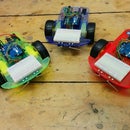Introduction: Battery Voltage Monitor
This voltage monitor has been designed to remotely display battery voltage so that people monitor and maintain their batteries easily. It was designed for use on off-grid reneable energy systems (such as my solar PV system), but it would also be useful to anyone who has a lead-acid battery, such as caravans, boats and cars.
It is designed to plug in to a car 'cigar lighter' socket and display the voltage on a remote LED display. Here are the plans to make your own.
Step 1: Parts and Tools Required
- 3mm plywood sheet (around 1/3 sheet of A4)
- Wood glue
- 2 x M3 machine screws (around 12mm long)
- 2 x M3 nuts
-
4-digit LED display
- I used this one from SunTekStore (but available at other places including eBay):
- http://www.suntekstore.co.uk/product-14002344-036inch_4_digit_digital_panel_voltmeter_0-33v_red_led_voltmeter.html
-
On/off switch
- I used this one from SunTekStore (but any switch would work):
- http://www.suntekstore.co.uk/product-14001517-black_mini_size_spdt_slide_switch.html
- 2m of twin (red/black) cable
- 'Cigar ligher' type plug
- Access to a laser cutter - such as at your local hackspace
- Soldering iron and solder
- Side cutters or wire strippers
- Posidrive screwdriver
Step 2: Cut the Enclosure
For this step you will need access to a laser cutter. I use the one at my local hackspace in Nottingham (http://nottinghack.org.uk/).
The .dxf file is attached here. It is also attached as a .pdf for viewing. You are cutting 5 pieces (rather than the 4 shown in the photo) which will all stack on top of each other to create the enclosure.
Please feel free to adapt this as you would like.
(Edit 15/11/12: New version of the .dxf files has been uploaded)
Step 3: Glue the Enclosure
The enclosure is made from a stack of laser cut pieces. The bottom three pieces are glued together and this holds the two M3 nuts in place. The top two pieces are held in place with the two M3 machine screws. This means you can open the enclosure again, for any reason.
Step 4: Solder the Display and Switch
The next step is to feed the cable through the small hole in the enclosure.
Also push the small slider switch into the smaller hole in the front of the enclosure.
Strip the cable back around 5mm. Remove the black cable on the LED display and solder the black wire (of the red/black cable) to the same point on the LED display.
The red wire of the LED display is the power supply and the green wire is the voltage monitoring wire - in this case they are the same thing, so we connect them together and wire them to the switch.
Wire the red cable of the red/black cable to the switch and solder.
Step 5: Fit in the LED Display
The wires and switch are soldered. We now need to use the last two laser cut pieces to close up the LED display unit.
Apply some hot melt glue to hold the display into place. Ensure not too much glue is used as it could stop the unit from closing correctly.
Use the M3 machine screws to clamp the unit closed.
Step 6: Solder the 12V Plug
Open the plug by removing the black screw and the front metal connector (this unscrews and then the metal disk pulls off)
Push the red/black cable through the cable grip. This is hard work as the hole is only just the right size. Use some long nose pliers to pull the cable through.
Put the red wire through the spring and solder on the connector.
Solder the black wire to one of the side connectors.
Screw together the plug and put back the metal disk and fuse and end connector.
Step 7: Plug in and Monitor Your Voltages
Now you can remotely monitor your battery voltage. Please have a look at these articles for more detail on how battery voltage relates to state of charge of your battery:
- http://www.scubaengineer.com/documents/lead_acid_battery_charging_graphs.pdf
- http://www.re-innovation.co.uk/web12/index.php/en/info-sheets/battery-worksheet
- http://www.re-innovation.co.uk/web12/index.php/en/products-2/battery-voltmeter-shop

Participated in the
Instructables Design Competition















